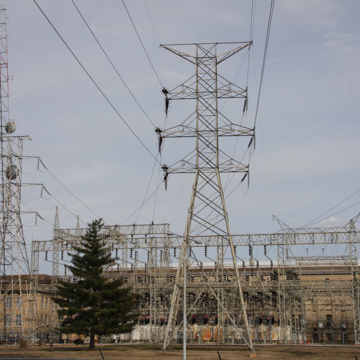Located just upstream from Florence, Alabama, and spanning the Tennessee River, Wilson Dam is the longest-operating hydroelectric facility in the Tennessee Valley Authority (TVA), and the first dam to become a part of the TVA system. Wilson Dam, along with 15 other dams built by the TVA in the region, including two in Alabama—Wheeler Dam (1933–1936) and Guntersville Damn (1935–1939)—provided a 652-mile-long shipping channel from the Ohio River in Kentucky to Knoxville, Tennessee. The Tennessee River between Decatur and Florence, Alabama, drops over 130 feet in elevation, creating a series of rapids (known as shoals) that hampered river navigation, effectively isolating the upper Tennessee Valley from major inland waterways. Canal work in the 1800s improved shoal navigation for smaller vessels, but was not sufficient to allow larger vehicles. By the late 1800s, federal funding was obtained to address improvements but navigation was still limited. Built by the U.S. Army Corps of Engineers, in part to provide power for nitrate production during World War I, Wilson Dam eventually became the center of a national discourse over national natural resource use, the distribution of electric power, and even the role of government in promoting the development in the Tennessee Valley, ultimately leading to the establishment of the TVA.
Wilson Dam is a concrete gravity dam, designed to hold back water by utilizing the weight of the material to resist the pressure against it. Gravity dams are classified by height, and Wilson Dam is considered of medium height, at 137 feet tall. The reservoir behind the dam, Lake Wilson, has a flood storage capacity of 50,500 acre-feet. The dam’s large span of 4,541 feet made it the longest hydroelectric dam in the world upon its completion. Each of the 21 inward-flow (Francis) turbines efficiently generate 35,000 horsepower each. A single spillway gate can discharge 12,175 cubic feet of water per a second. The dam has 49 of these gates, earning it the nickname, “Niagara of the South.” The turbines can produce 663 megawatts of power each day, making it the most powerful of the conventional dams operated by the TVA. The dam has two locks, on the north end of the structure. The newest lock, constructed in 1959, is the largest single chamber in the world and the highest single lift lock east of the Rocky Mountains. More than 3,700 vessels pass through the locks each year. State Route 133 traverses the top of the dam on a 20-foot-wide roadway.
Wilson is the only classically styled dam in the TVA system. The stylized references to Classical Roman design elements is unusual; the repeating arcade along the spillway is reminiscent of the Roman Pont du Gard. The geometric formality of the powerhouse, located at the end of the dam on the southern bank of the river, faintly echoes the formality of classical structures with its formal square pilasters that rhythmically adorn the front elevation. This level of stylistic detailing is not found on other dams in the TVA system, and is likely due to the structure’s early build date. The majority of the TVA dams were built after 1930, and are far more utilitarian and modern in design, fitting the austerity of the Depression era and the world war that followed it.
Wilson was designed to provide power for nitrate plants. President Wilson, the dam’s namesake, ordered the U.S. Army Corps of Engineers to build two nitrate plants at Muscle Shoals to produce explosives for World War I. Construction of the dam and associated nitrate plants entailed significant resources and coordination. More than 18,000 workers were housed at the construction camp, with total camp population numbering 21,000 at its peak. There were 23 mess halls, requiring almost a thousand workers to prepare meals. The largest mess hall on the site seated 4,000 people. Free schools provided education to almost 850 children.
When the war ceased, there was no longer a need for the munitions plant, and Henry Ford tried to purchase the facilities at Muscle Shoals, wanting to use their cheap electricity. However, Senator George Norris (Nebraska) felt that the dam and the nitrate facilities could serve to address the three major challenges in the valley: persistent flooding, lack of electrical power, and heavily eroded soil from poor farming practices. Norris wanted additional dams to assist in overcoming these challenges. The plan originally stalled in Congress, but by 1933, in the midst of the Great Depression, President Franklin D. Roosevelt made the TVA plan part of his New Deal legislation. The TVA Act made the TVA responsible for protecting natural resources, improving commerce, agriculture, and river navigation in the region. The dam served as headquarters for the TVA’s original agricultural and chemical programs. When the TVA took control of the dam, the nitrate plants were utilized for fertilizer production. During World War II, power from Wilson Dam was used to operate nitrate and phosphorous factories that supplied munitions operations at Muscle Shoals. Power from the TVA also supported the Manhattan Project, which operated at Oak Ridge, Tennessee. The facility used almost one-seventh of all electricity produced in the United States to enrich uranium for the atomic bomb. By the end of 1944 the TVA employed more than 50,000 workers and in the span of a decade, regional trade in the area increased by more than 400 percent. The Wilson Dam site currently serves as a training facility for all of the TVA’s hydroelectric workers.
References
Rettig, Polly and Horace J. Sheely, Jr. “Wilson Dam,” Colbert County, Alabama. National Register of Historic Places Inventory–Nomination Form, 1966 (revised 1976). National Park Service, U.S. Department of the Interior, Washington, D.C.



















